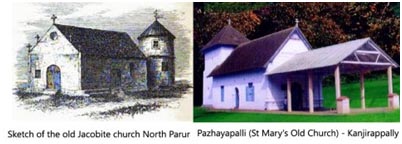I
Parur
Church and the Shape of Old Kerala Churches
These comments by Prof. George
Menachery are vis-a-vis rhe following article by
Khristós Agápē:
“There are few, if any, Syrian churches in
Kerala that preserve the architecture that existed prior to the
16th century. One church that was still in existence during the
early 1800s was the ancient church in Parur. Here is an account
from “Lingerings of Light in a Dark Land”, by the Rev Thomas
Whitehouse, M.A., formerly Minister of the Government Church,
Cochin, and afterwards Principal and Chaplin of the Lawrence
Military Asylum (aka Lovedale), Ootacamund, South India. (1873):
Buchanan (Rev. Claudius Buchanan) was there (Parur) in 1806, and
in the second volume of his memoirs by Pearson there is an
engraving of the old church (in Parur) which he found there. If
it be at all a correct representation, it was very unlike all
other Syrian Churches now existing in Malabar, especially in
it’s having no raised chancel , but a round tower at the extreme
end (east end) of the building – towers of any kind being very
unusual in their churches. In his book Christian Researches he
speaks thus: “Not far from Cranganore is the town of Parur,
where there is an ancient Syrian Church, which bears the name of
Apostle Thomas. It is supposed to be the oldest in Malabar, and
is still used for divine service. I took a drawing of it.
The old church, sketeched by Buchanan, no longer exists. Major
Mackworth, visiting the place in 1821, calls it the oldest
church in possession of the Jacobite Syrians, and states that
another was then building in its room. The church now occupied
by them is a spacious building, and singular to say, has a
square bell tower of four stories on the left hand side of the
front entrance. The idea of the tower has been borrowed from
Romish structures as at Verapoli, Balarpat, and Ernaculum.
Foot note: This venerable structure was one of many burnt by
Tippoo Saib’s soldiers when they invaded Travancore in 1790. The
injuries then received had probably led to another building
being necessary.”

Remarks by Prof. George
Menachery:
I do agree that the said
Parur church is given as the
oldest church structure in
Kerala by some writers. I
have myself reproduced a
picture of the church forty
years back in the St. Thomas
Christian Encyclopaedia of
India, Vol. II, 1973,right
side end paper which I had
taken from the "Travels of
Marco Polo," Vol.II, by
Yule, edited by Cordier,
London, 1926. This church is
described as the oldest
existing structure only
because sketches of other
churches were not available
to the writers concerned. In
Parur itself there is an old
church where Roz and other
bishops were buried. We must
remember that there were no
less than one hundred church
buildings in Kerala at the
time of the Synod of Diamper,
1599. There are many
detailed references to the
churches in the "Jornada,"
Coimbra, 1606 and in the
various Acts and Decrees of
the Synod. (cf. e.g. Geddes,
1694, reproduced in the
Indian Church History
Classics, Vol. I, The
Nazranies, ed. George
Menachery). There are
references to the Syrian
churches of Kerala in Joseph
the Indian, 1500, ed. the
late Antony Vallavanthara
and also in the letter of
the four bishops, 1504. The
story of Vasco da Gama
mistaking a temple for a
church is well known. The
impression we get from all
these sources is that the
churches at the beginning of
the 17th C. were more or
less like the typical old
churches of the early 20th
C., except for the
Portuguese facades and the
interior Baroque
decorations. For more
details on this matter cf.
the various volumes referred
to and the numerous
photographs.in those
volumes. - Prof. George
Menachery.
